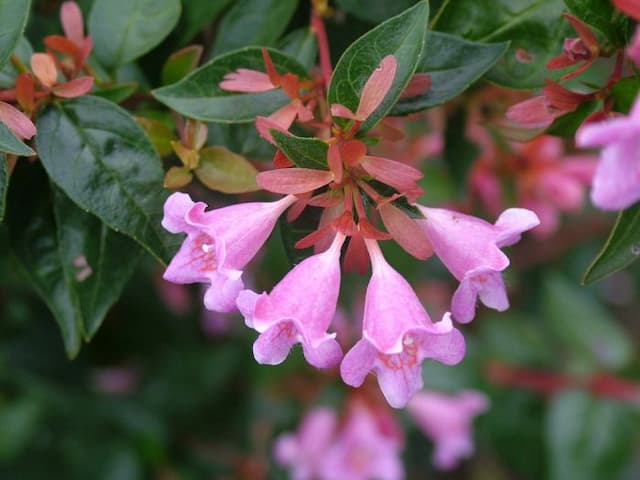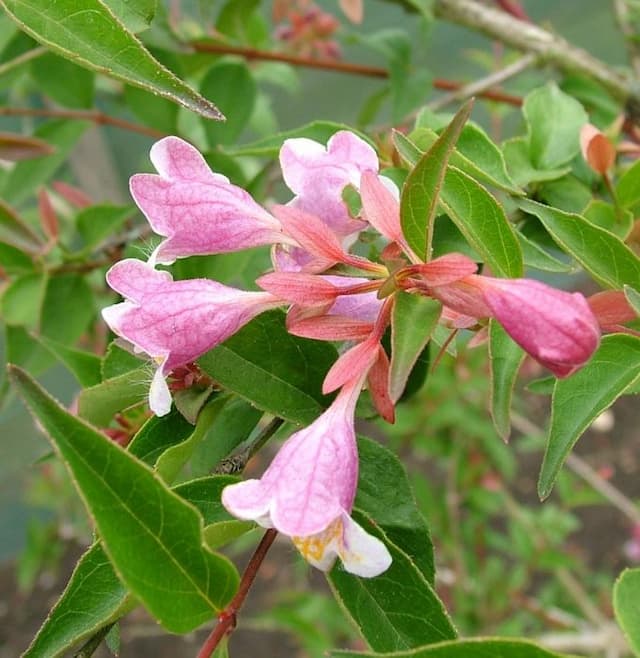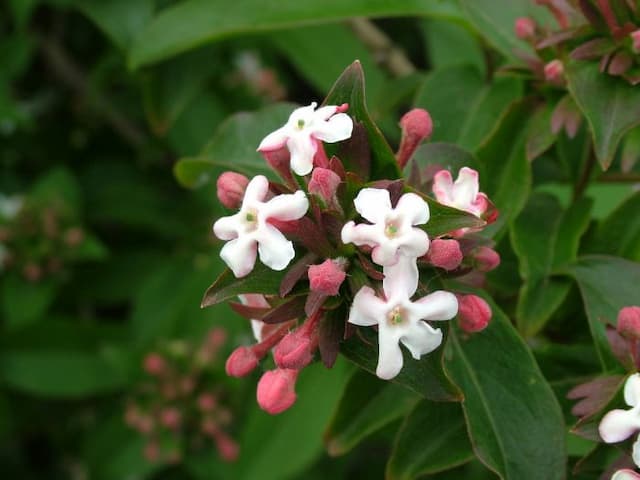Henry's Honeysuckle Lonicera henryi 'Copper Beauty' (PBR)

ABOUT
Copper Beauty, known commonly as Henry's Honeysuckle, is an evergreen climber renowned for its attractive foliage and stunning flowers. This plant boasts oval-shaped leaves that showcase a rich green color, while the newer growth is often tinged with a coppery hue, lending it the name 'Copper Beauty'. The true visual delight comes from the abundant flowers that emerge in summer. The blossoms are tubular in shape, displaying a two-tone palette where the outside is painted in a creamy yellow while the throats reveal a vibrant red-purple tone. This contrast is striking and is a magnet for pollinators, including bees and hummingbirds. The flowers eventually give way to small, red berries that are as attractive to birds as the flowers are to insects. Overall, Henry's Honeysuckle is a lush, vining plant that adds texture, color, and life to any garden environment where it gracefully climbs over trellises, fences, or other supporting structures.
About this plant
 Names
NamesFamily
Caprifoliaceae.
Synonyms
Henry's Honeysuckle, Copper Beauty Honeysuckle.
Common names
Lonicera henryi 'Copper Beauty' (PBR)
 Toxicity
ToxicityTo humans
Henry's honeysuckle is generally considered non-toxic to humans. However, as with many plants, individual reactions can vary, and some people may experience mild stomach upset if any part of the plant is ingested. It's always a good practice to avoid eating any plant parts unless they are known to be edible.
To pets
Henry's honeysuckle is not known to be toxic to pets. It is not listed among the commonly recognized toxic plants for dogs and cats. However, it is always a good idea to prevent pets from ingesting plants, as individual animals could have unique sensitivities, and non-toxic plants could still cause gastrointestinal upset if consumed.
 Characteristics
CharacteristicsLife cycle
Perennials
Foliage type
Evergreen
Color of leaves
Varies
Flower color
Yellow
Height
6 feet 6 inches (2 meters)
Spread
6 feet (1.8 meters)
Plant type
Climber
Hardiness zones
9
Native area
China
Benefits
 General Benefits
General Benefits- Attractive Foliage: Lonicera henryi 'Copper Beauty' has beautiful coppery young leaves that mature to a rich green, adding various shades of color to the garden through different seasons.
- Fragrant Flowers: It produces sweetly scented, yellow and pink bicolored flowers that can bring a pleasant fragrance to your garden space.
- Wildlife Attractant: The flowers can attract hummingbirds and beneficial insects such as pollinators to the garden, which can help with the pollination of other plants.
- Long Flowering Period: It blooms from late spring into late summer, providing a long season of visual appeal.
- Climbing Habit: As a climbing plant, it can be used to cover fences, walls, trellises, and other structures, which is perfect for creating vertical interest in the landscape.
- Easy to Grow: It is considered an easy-to-care-for plant that is quite adaptable to a variety of growing conditions and is relatively low maintenance once established.
- Durability: The plant is hardy and can withstand cold temperatures, making it suitable for growing in many climates without the need for extensive winter protection.
- Evergreen: It retains its leaves throughout the year, providing continuous coverage and color even when other plants have died back in the winter.
 Medical Properties
Medical PropertiesThis plant is not used for medical purposes.
 Air-purifying Qualities
Air-purifying QualitiesThis plant is not specifically known for air purifying qualities.
 Other Uses
Other Uses- Crafting Material: The flexible stems of Lonicera henryi can be woven into wreaths or used in basketry.
- Natural Dye: The plant's leaves and stems can potentially be boiled down to create natural dyes for fabrics or fibers.
- Garden Structure: Can be trained to grow over arbors or trellises, serving as a living architectural feature in gardens.
- Bird Habitat: It provides a dense foliage cover which can be used by birds for nesting or shelter.
- Photography Backdrop: The plant's lush growth and pretty flowers make it a lovely background for garden photography.
- Educational Tool: Lonicera henryi can be used to teach principles of botany and horticulture, including plant growth habits and pruning techniques.
- Landscape Design: Used as a privacy screen or to hide unsightly parts of the garden, like compost bins or utility areas.
- Living Fences: When grown closely together, they can serve as a living fence, adding a green boundary to your property.
- Scented Gardens: The fragrant flowers can contribute to a sensory garden experience.
- Floral Arrangements: Although not conventional, cut stems with flowers can potentially be used in floral decorations for their ornamental value.
Interesting Facts
 Feng Shui
Feng ShuiThe Henry's Honeysuckle is not used in Feng Shui practice.
 Zodiac Sign Compitability
Zodiac Sign CompitabilityThe Henry's Honeysuckle is not used in astrology practice.
 Plant Symbolism
Plant Symbolism- Devotion: Honeysuckles, including Lonicera henryi 'Copper Beauty', often symbolize devoted affection and the bonds of love, possibly due to their ability to twine closely around structures and other plants.
- Generosity: With their abundant and sweet-smelling flowers, honeysuckles can represent the giving nature of a person, sharing kindness and empathetic feelings towards others.
- Happiness: The delightful fragrance and bright colors of the honeysuckle flowers are reminiscent of the joy and happiness that can be found in nature's simple pleasures.
- Protection: In folklore, honeysuckles are sometimes thought to ward off evil and are planted near homes for protection, reflecting the belief that this plant offers a safe haven or protective shield.
- Nostalgia: The scent of honeysuckle is often associated with childhood memories and the sweetness of the past, thus symbolizing nostalgia and the longing for simpler times.
 Water
WaterHenry's honeysuckle requires regular watering, especially during dry spells. It should be watered deeply once a week, with about 1-2 gallons of water per session, depending on the size and maturity of the plant. During the hotter months, you may need to water twice a week, ensuring the soil stays evenly moist but not saturated. Over-watering should be avoided as it can lead to root rot. Reduce watering in the winter when the plant is dormant.
 Light
LightHenry's honeysuckle thrives in full sun to partial shade. It prefers a spot that receives at least 6 hours of direct sunlight daily. When planted in a location that gets too much shade, it may not flower as profusely. To optimize growth and flowering, pick a spot with morning sun and afternoon dappled shade or one with sunlight throughout the day that's not excessively harsh.
 Temperature
TemperatureHenry's honeysuckle is hardy and can tolerate a range of temperatures, but it performs best between 60°F and 75°F. Though it can survive temperatures as low as 0°F, prolonged exposure to such cold may harm the plant. In areas with extreme heat, providing afternoon shade can help protect the plant when temperatures exceed 85°F.
 Pruning
PruningHenry's honeysuckle should be pruned to maintain shape and encourage vigorous growth. Prune in late winter or early spring before new growth starts. Remove any dead or damaged stems, and cut back about one-third of the older stems to promote new shoots. It can also be lightly pruned after flowering to maintain its desired form.
 Cleaning
CleaningAs needed
 Soil
SoilHenry's Honeysuckle (Lonicera henryi 'Copper Beauty') thrives in well-drained soil with a mix of loam, sand, and organic matter like compost or peat moss to ensure proper drainage and fertility. The soil pH should ideally be between 5.5 and 7.5, making it slightly acidic to neutral.
 Repotting
RepottingHenry's Honeysuckle does not typically require frequent repotting. It should be repotted if it becomes root-bound or the soil is depleted, approximately every 2 to 3 years.
 Humidity & Misting
Humidity & MistingHenry's Honeysuckle prefers an outdoor environment with natural humidity levels, but it is adaptable and can tolerate dry air. There is no specific humidity level requirement for this plant.
 Suitable locations
Suitable locationsIndoor
Provide bright light, moderate water, and yearly pruning.
Outdoor
Plant in sun or partial shade; water regularly.
Hardiness zone
4-9 USDA
 Life cycle
Life cycleLonicera henryi 'Copper Beauty' (PBR), commonly known as Henry's honeysuckle, begins its life when seeds germinate in spring under suitable conditions of warmth and moisture, or through vegetative propagation from cuttings. The seedlings rapidly grow into young vines, with the first year focused on establishing a strong root system and foliage growth. As the vine matures into its second and third year, it begins to flower, producing fragrant, two-toned flowers that are attractive to pollinators in late spring and early summer. Following pollination, the plant may produce small berries that contain seeds, allowing for the dispersal and propagation of new plants. Henry's honeysuckle is a perennial, woody climber that will continue to grow and potentially bloom each year, with the ability to reach up to 10 meters in height if supported. Over time, the plant may require pruning to maintain shape and encourage rejuvenative growth, ultimately reaching senescence as it ages beyond its most productive years.
 Propogation
PropogationPropogation time
Spring-Early Summer
The Lonicera henryi 'Copper Beauty', commonly known as Henry's Honeysuckle, is typically propagated through semi-hardwood cuttings. This method is generally conducted in late summer. To perform this propagation, a cutting of about 4 to 6 inches (10 to 15 centimeters) is taken from the current year’s growth, ensuring that a few leaves remain on the upper part. The lower end of the cutting should be dipped in rooting hormone powder to enhance root development. Then, the cutting is planted in a pot filled with a mixture of peat and perlite or a soilless potting mix, and kept moist under indirect sunlight. The container should be covered with plastic or placed in a propagator to maintain humidity, and roots typically develop within a few weeks. After rooting is established, the new plant can be gradually acclimatized to outdoor conditions and finally planted out.







![Himalayan honeysuckle [Golden Lanterns]](/_next/image?url=https%3A%2F%2Fplants-admin.emdemapps.com%2Fimages%2Fplants%2F%2Fimages%2F604b55302cc87.png&w=640&q=75)

